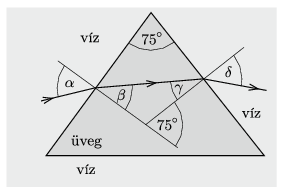 Problem P. 5139. (May 2019)
Problem P. 5139. (May 2019)
P. 5139. A monochromatic light beam enters into a glass prism of vertex angle \(\displaystyle 75^\circ\). The prism is in water, and the angle of incidence of the light beam is \(\displaystyle 45^\circ\). The light beam emerges from the glass after two refractions. \(\displaystyle a)\) How and by what percent does the wavelength of the light change when the light emerges from the glass and enters into the water? \(\displaystyle b)\) By what angle does the direction of the light beam which emerges from the glass after the two refractions change with respect to that of the incident ray? \(\displaystyle c)\) At what angle of incidence would the light beam not emerge from the prism at the second boundary? The refractive index of glass is \(\displaystyle \frac32\), and that of the water is \(\displaystyle \frac43\).
(4 pont)
Deadline expired on June 11, 2019.
Sorry, the solution is available only in Hungarian. Google translation
Megoldás. \(\displaystyle a)\)Az üvegnek a vízre vonatkoztatott (relatív) törésmutatója
\(\displaystyle n=\frac{n_\text{üveg}}{n_\text{víz}}=\frac{3}{2}\cdot \frac{3}{4} =\frac{9}{8}=1{,}125.\)
A vízben a fény terjedési sebessége \(\displaystyle n\)-szer akkora, mint az üvegben, a frekvencia pedig nem változik, így
\(\displaystyle \frac{v_\text{víz}}{v_\text{üveg}}=\frac{\lambda_\text{víz}}{\lambda_\text{üveg}}=1{,}125.\)
Az üvegből a vízbe kilépő fény hullámhossza tehát 12,5%-kal megnő.
\(\displaystyle b)\) Legyen az ábrán látható módon az első fénytörésnél a beesési szög \(\displaystyle \alpha\), a törési szög \(\displaystyle \beta\), a második határfelületnél a beesési szög \(\displaystyle \gamma\), a törési szög pedig \(\displaystyle \delta\).

A Snellius–Descartes-törvény és geometriai összefüggések szerint fennáll, hogy
| \(\displaystyle (1)\) | \(\displaystyle \frac{\sin\alpha}{\sin\beta}=\frac{9}{8},\) |
| \(\displaystyle (2)\) | \(\displaystyle \beta+\gamma=75^\circ,\) |
| \(\displaystyle (3)\) | \(\displaystyle \frac{\sin\delta}{\sin\gamma}=\frac{9}{8},\) |
és a fénysugár eltérülési szöge (az ún. deviáció)
| \(\displaystyle (4)\) | \(\displaystyle \Delta=(\alpha-\beta)+(\delta-\gamma).\) |
Esetünkben \(\displaystyle \alpha=45^\circ\), és ebből az (1)-(4) összefüggéseket alkalmazva lépésenként számolható, hogy
\(\displaystyle \beta=38{,}9^\circ, \qquad \gamma=36{,}1^\circ, \qquad \delta=41{,}5^\circ, \qquad \Delta=11{,}5^\circ.\)
\(\displaystyle c)\) Alkalmazzuk a (3), (2) majd az (1) összefüggést! A fény nem lép ki az üvegből, ha \(\displaystyle \sin\gamma>\frac89\) vagyis \(\displaystyle \gamma>62{,}7^\circ\) (ekkor teljes visszaverődés történik). Ilyenkor \(\displaystyle \beta<12{,}3^\circ\), és végül \(\displaystyle \alpha<13{,}8^\circ\).
Statistics:
27 students sent a solution. 4 points: Békési Ábel, Olosz Adél, Sal Dávid, Tiefenbeck Flórián, Toronyi András, Vass Bence. 3 points: Bukor Benedek, Csécsi Marcell, Fiam Regina, Hartmann Alice, Kalmár Dóra, Keltai Dóra, Lipták Gergő, Mácsai Dániel, Makovsky Mihály, Máth Benedek, Molnár Mátyás, Selmi Bálint, Tanner Norman, Viczián Anna. 2 points: 6 students. 1 point: 1 student.
Problems in Physics of KöMaL, May 2019
